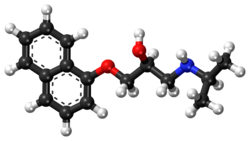普萘洛尔
普萘洛爾(Propranolol)屬於一種非選擇性β受体阻断药[1],常用於治療高血壓、多種心律不整、甲状腺功能亢进症、微血管瘤、表演焦慮症,以及本態性顫抖等[1][2][3]。本品可用於預防偏頭痛,以及心绞痛及心肌梗塞發生後的後續心臟問題[1]。本品可經口服或靜脈注射給藥,口服藥劑有分短效型及長效型[1]。服藥後30分鐘藥物會出現於血液中,60至90分鐘後則會達到最大藥效[1][4]。
 | |
 | |
| 臨床資料 | |
|---|---|
| 商品名 | Inderal |
| AHFS/Drugs.com | Monograph |
| 核准狀況 |
|
| 懷孕分級 |
|
| 给药途径 | 口服、肛門塞劑、直腸、靜脈注射 |
| ATC碼 | |
| 法律規範狀態 | |
| 法律規範 |
|
| 藥物動力學數據 | |
| 生物利用度 | 26% |
| 药物代谢 | 肝臟 (extensive) 1A2, 2D6; minor: 2C19, 3A4 |
| 生物半衰期 | 4–5 小時 |
| 排泄途徑 | 腎(<1%) |
| 识别信息 | |
| |
| CAS号 | 525-66-6 |
| PubChem CID | |
| IUPHAR/BPS | |
| DrugBank | |
| ChemSpider | |
| UNII | |
| KEGG | |
| ChEBI | |
| ChEMBL | |
| CompTox Dashboard (EPA) | |
| ECHA InfoCard | 100.007.618 |
| 化学信息 | |
| 化学式 | C16H21NO2 |
| 摩尔质量 | 259.35 g·mol−1 |
| 3D模型(JSmol) | |
| 手性 | 外消旋混合物 |
| |
| |
常見副作用包含恶心、腹痛,以及便秘等等。心跳过缓及心臟衰竭患者不宜使用。冠狀動脈疾病患者過快停藥可能會導致症狀惡化。本品可能會惡化哮喘的症狀,肝腎功能不佳的用藥者須多加留意[1]。妊娠期間用藥可能會對胎兒造成不良影響[5]。哺乳期間用藥應屬安全,但仍須注意幼兒是否有副作用產生[6]。
普萘洛尔於1964年發現[7][8]。本品列名於世界卫生组织基本药物标准清单,為基礎公衛體系必備藥物之一[9]。本品屬於通用名药物[1]。2014年,在发展中国家每月劑量的價格在 0.24 至 2.16 美金之間[10]。在美國每月劑量則約為 15 美金[1]。
藥理作用
编辑藥理作用有如下幾種。
- 非選擇阻抑β受體、高劑量直接抑制心肌、減少心輸出量、降低心搏率、減少心臟負荷、用於預防心絞痛
- 降壓由於:(1)降低心輸出量;(2)影響腎酶(renin)與血管收縮素系統
- 增加胰島素(insulin)抗藥性及減少葡萄糖耐性,會遮蓋低血糖引起心悸作用
副作用
编辑有噁心、嘔吐、腹瀉、便秘、憂鬱及倦怠感。另外支氣管氣喘、充血性心衰竭及接受口服降血糖藥的糖尿病病人禁用。產生副作用時不可驟然停藥,否則易發生心絞痛或心臟再次受損,甚至猝死[11]。
參考文獻
编辑- ^ 1.0 1.1 1.2 1.3 1.4 1.5 1.6 1.7 Propranolol hydrochloride. Monograph. The American Society of Health-System Pharmacists. [2015-01-01]. (原始内容存档于2020-05-19).
- ^ Davidson, JR. Pharmacotherapy of social anxiety disorder: what does the evidence tell us?. The Journal of Clinical Psychiatry. 2006,. 67 Suppl 12: 20–6. PMID 17092192.
- ^ Chinnadurai, S; Fonnesbeck, C; Snyder, KM; Sathe, NA; Morad, A; Likis, FE; McPheeters, ML. Pharmacologic Interventions for Infantile Hemangioma: A Meta-analysis.. Pediatrics. February 2016, 137 (2): e20153896. PMID 26772662. doi:10.1542/peds.2015-3896.
- ^ Bryson, Peter D. Comprehensive review in toxicology for emergency clinicians 3. Washington, DC: Taylor & Francis. 1997: 167 [2017-01-30]. ISBN 9781560326120. (原始内容存档于2020-12-15).
- ^ Prescribing medicines in pregnancy database. Australian Government. 2014-03-03 [2014-04-22]. (原始内容存档于2014-10-09).
- ^ Gerald G. Briggs, Roger K. Freeman, Sumner J. Yaffe. Drugs in pregnancy and lactation : a reference guide to fetal and neonatal risk 9th. Philadelphia: Wolters Kluwer Health/Lippincott Williams & Wilkins. 2011: 1226 [2017-01-30]. ISBN 9781608317080. (原始内容存档于2017-02-14).
- ^ Russell, RM. The enigma of beta-carotene in carcinogenesis: what can be learned from animal studies.. The Journal of Nutrition. January 2004, 134 (1): 262S-268S. PMID 14704331.
- ^ Ravina, Enrique. The evolution of drug discovery : from traditional medicines to modern drugs 1. Aufl. Weinheim: Wiley-VCH. 2011: 331 [2017-01-30]. ISBN 9783527326693. (原始内容存档于2017-02-14).
- ^ WHO Model List of Essential Medicines (19th List) (PDF). World Health Organization. April 2015 [2016-12-08]. (原始内容存档 (PDF)于2016-12-13).
- ^ Propranolol. International Drug Price Indicator Guide. [January 2016].[永久失效連結]
- ^ Propranolol. [2016-01-01]. (原始内容存档于2021-01-26).
外部連結
编辑- Stapleton, M. P. Sir James Black and propranolol. The role of the basic sciences in the history of cardiovascular pharmacology. Texas Heart Institute Journal. 1997, 24 (4): 336–342 [2021-11-10]. ISSN 0730-2347. PMC 325477 . PMID 9456487. (原始内容存档于2021-11-10).
- U.S. National Library of Medicine: Drug Information Portal - Propranolol (页面存档备份,存于互联网档案馆)